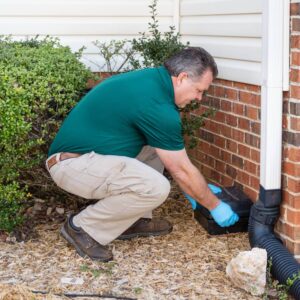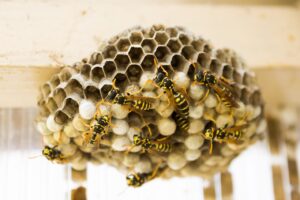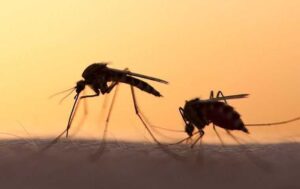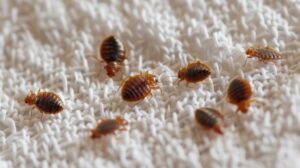
Fast
Local Service

Satisfaction Guaranteed

Fast
Local Service

Satisfaction Guaranteed


The Environmental Benefits of Professional Pest Control
The relationship between pest control and environmental protection is more interconnected than many people realize. While it might seem that pest management and ecological health are in conflict, professional pest control has evolved to become a critical part of sustainable home and community care. When done correctly, it can minimize harm to non-target species, reduce chemical overuse, and create long-term balance between humans and nature. With increasing awareness of environmental responsibility, more pest control companies are prioritizing integrated methods that not only remove pests but also protect the ecosystems that surround our homes. Whether addressing rodents, stinging insects, or nuisance birds, professionals are trained to use safe, targeted approaches that deliver results with minimal environmental impact. This article explores how professional pest control supports sustainability and why it remains a smarter alternative to improvised, at-home solutions. Reducing Overreliance on Chemicals One of the most significant environmental benefits of professional pest control is the careful and minimal use of pesticides. Many DIY treatments rely heavily on store-bought sprays and baits that often contain harsh chemicals. These are typically applied without proper knowledge of dosage, timing, or placement, leading to unnecessary exposure for non-target species, including pets, pollinators, and local wildlife. In contrast, licensed professionals use integrated pest management (IPM) practices. This approach emphasizes prevention, monitoring, and selective treatment, only applying chemical products when absolutely necessary. When they are used, they are applied in precise locations and quantities based on the pest biology and behavior. Professionals also have access to eco-friendly formulations that are designed to break down quickly in the environment, reducing long-term contamination. Through proper identification and targeted treatment, pest control experts can eliminate infestations without harming beneficial organisms or introducing harmful residues into local ecosystems. Protecting Beneficial Insects and Wildlife Not all insects are pests. In fact, many play essential roles in pollination, decomposition, and the food chain. Unfortunately, widespread chemical applications and indiscriminate DIY treatments often affect these helpful species. This can lead to unintended disruptions in local biodiversity, including the decline of bee populations, butterfly activity, and predator insects like ladybugs and dragonflies. Professional pest control takes the surrounding ecosystem into account when implementing treatment plans. For example, when dealing with bees, hornets, or wasps, experts are trained to distinguish between nuisance stingers and protected pollinators. Understanding how to manage these populations safely is critical, especially around homes and gardens. For more insight, explore tips on dealing with stinging insects safely in residential areas. Preventing Damage to Structures and Habitats While pests can be destructive indoors, they also pose a risk to natural and built environments when left uncontrolled. Rodents, for example, can damage insulation, wiring, and structural materials. Outdoors, they may disturb nesting birds, burrow into soil around foundations, and contaminate water sources. Invasive bird species like pigeons or starlings may displace native birds or cause sanitation issues with their droppings. Professional pest control provides a long-term solution to these challenges by addressing pest populations in a way that minimizes habitat disruption. Their work often involves exclusion techniques that reinforce homes without harming wildlife. This might include sealing entry points, installing mesh over vents, or cleaning up attractants that draw animals into residential areas. The goal is to create a barrier between the home and the pest without altering or damaging the larger ecosystem. You can learn more about these concerns in this guide to understanding nuisance birds, which explains how to strike a healthy balance with nature. Environmentally Responsible Strategies Used by Professionals Professionals are trained in environmentally conscious strategies that reduce the need for repeat treatments and prioritize long-term outcomes. These methods are rooted in science and sustainability, offering homeowners a way to manage pest issues while being good stewards of the environment. Why Sustainable Pest Control Starts with Expertise The effectiveness and environmental responsibility of pest control depend heavily on expertise. Without proper training, even well-intentioned efforts can cause harm. Using the wrong product, treating the wrong species, or failing to follow up properly often leads to recurring infestations and unnecessary exposure to chemicals. Pest control professionals are equipped not just with better tools but with a deeper understanding of how to identify pests, assess contributing factors, and choose treatments that solve the problem while protecting surrounding life. They also help homeowners make informed choices about maintenance, sanitation, and prevention that reduce the need for future intervention. When pest management is handled by those who understand its environmental impact, the result is a healthier home and a healthier ecosystem. This makes professional service not only more effective, but also the more responsible choice for those who care about their environmental footprint. Partnering with Greenville Pest Control Responsible pest control should protect your home without harming the planet. If you’re looking for effective, sustainable solutions backed by science and care, reach out to our team at Greenville Pest Control to schedule an expert inspection and customized treatment plan.

Tips for Preventing Pest Problems Before They Start
Pest problems rarely start with a sudden invasion. Most infestations develop gradually, often going unnoticed until pests have already settled in. By the time obvious signs like droppings, damaged food packaging, or scratching sounds appear, pests are usually well-established. The most effective way to avoid this is by adopting a proactive approach to pest control. Preventing pest problems before they start means addressing the conditions that attract pests, blocking their entry points, and making your home less accommodating. A pest-free home requires awareness, consistency, and expert guidance. This article outlines professional strategies to help you protect your space from unwanted guests throughout the year. Block Pest Entry Points Early One of the most important steps in preventing pest problems is securing the perimeter of your home. Pests often enter through small, overlooked gaps in foundations, vents, siding, or around pipes. Sealing these openings significantly reduces the chances of an infestation taking hold. These simple fixes make it far more difficult for pests like rodents, cockroaches, and ants to enter in the first place. This blog post on sealing entry points goes into further detail about how small gaps can quickly lead to larger problems. Maintain a Clean and Uncluttered Living Space Cleanliness is more than a matter of hygiene when it comes to pest prevention. Pests are drawn to cluttered environments where food, water, and shelter are easy to find. Eliminating attractants inside the home is a key part of any prevention plan. By making your living space less accessible to pests, you reduce the odds of attracting them in the first place. A clean home also allows you to spot early warning signs before an infestation spreads. Address Moisture and Drainage Issues Moisture is one of the most overlooked contributors to pest problems. Many insects and rodents are drawn to areas with high humidity or standing water, which offer ideal conditions for nesting and reproduction. Preventing pest problems includes keeping your home dry, ventilated, and free of water buildup. When moisture is eliminated, pests such as termites, ants, and silverfish are far less likely to thrive. This type of prevention helps protect both your health and your property. Monitor Outdoor Areas That May Invite Pests Your yard and exterior property play a major role in determining whether pests are likely to target your home. Outdoor clutter, overgrown landscaping, and poor sanitation create the perfect environment for pests to breed and eventually find their way indoors. Many pest problems begin outside before becoming visible indoors. Being proactive with landscaping and yard maintenance will reduce the risk of pests migrating into your home. Recognize When Professional Help Is Necessary Even with the best prevention efforts, pests can sometimes find their way in. Early signs like droppings, damage to insulation or packaging, and unexplained noises in the walls may indicate an emerging problem that needs expert attention. This is especially true for more difficult invaders like rodents. When pest activity is suspected, seeking professional inspection and treatment ensures the problem is identified and addressed before it escalates. Experts have the tools and training to locate hidden nests and apply safe, targeted control methods. For rodent concerns specifically, this rodent control guide explains what to expect from professional solutions.Pests are opportunistic and will take advantage of any condition that makes entry or survival easier. The best way to stay ahead of infestations is by being proactive. Focus on sealing access points, removing attractants, addressing moisture issues, and maintaining your property both inside and out. If you’re looking for long-term prevention and peace of mind, contact Greenville Pest Control for expert evaluation and tailored pest protection.

The Importance of Sealing Entry Points to Prevent Pests
Keeping pests out of your home or business starts with one of the most overlooked, yet powerful, strategies: sealing entry points. Small cracks, gaps, and holes in your building’s structure can become prime gateways for insects, rodents, and other pests. Addressing these vulnerabilities is an essential part of preventing infestations before they start. Sealing entry points isn’t just a quick fix, it’s a long-term solution that supports your overall pest management strategy. From limiting pest access to maintaining structural integrity, exclusion is a key element in keeping properties safe, healthy, and pest-free. Small Openings, Big Problems Pests only need the smallest access points to enter a structure. Rodents can squeeze through holes as tiny as a dime, and insects can slip through even finer gaps. These access points often appear around: Once pests get inside, they can quickly multiply, cause damage, and compromise health standards. Sealing these openings early helps prevent this chain reaction and eliminates one of the most common causes of infestation. Some invaders, like pavement ants in Greenville, can exploit even the tiniest cracks and create ongoing problems if not addressed proactively. Preventing Pest Access Limits the Need for Reactive Treatments One of the strongest advantages of sealing entry points is the reduced need for ongoing chemical treatments or emergency pest control visits. When pests are denied entry, the interior environment becomes far less vulnerable. Benefits include: By limiting access, you’re addressing the root cause rather than just the symptoms of pest activity. Entry Points Often Indicate Structural Weaknesses Gaps, cracks, and crevices in a building’s exterior don’t just invite pests, they can also signal underlying issues. These may include wood rot, shifting foundations, aging weatherproofing, or water damage. Each of these can attract a specific type of pest, from cockroaches to termites to mold-loving insects. In addition to pest prevention, sealing entry points often triggers necessary repairs that improve energy efficiency, insulation, and the overall durability of the structure. Trained professionals can help spot not only where pests may enter, but also why those areas became vulnerable in the first place. Seasonal Shifts Make Exclusion Even More Crucial Pest activity fluctuates with the seasons. As temperatures change, so does pest behavior. Sealing entry points before seasonal shifts can stop pests from moving in when they’re most likely to seek shelter indoors. Seasonal factors to consider: Prepping your structure ahead of these seasonal changes means you’re not caught off guard during peak activity times. Sealing Entry Points Supports Long-Term Pest Prevention Goals Pest control is most effective when it’s part of a long-range prevention strategy. Sealing entry points forms a foundational part of that approach, making other pest control methods more effective and reducing recurrence. Why sealing entry points supports long-term goals: Whether you’re dealing with ants, roaches, or looking to prevent bed bugs from spreading, exclusion gives you the defensive edge you need for long-term success. Professional Expertise Makes a Difference Identifying every possible entry point isn’t always easy. Some are hidden behind siding, under decks, inside crawl spaces, or at roof junctions. While some simple fixes can be handled by property owners, thorough and effective exclusion work benefits from professional expertise. Pest control specialists are trained to detect subtle signs of pest activity, assess building vulnerabilities, and apply durable materials that withstand seasonal weather and wear. Professionals also bring region-specific knowledge, helping tailor exclusion efforts to the exact types of pests most likely to threaten your property. Conclusion: Seal Now, Prevent Later Sealing entry points is one of the most practical, affordable, and effective steps you can take to prevent pests from ever becoming a problem. It supports long-term structural health, limits exposure to chemicals, reduces repair costs, and contributes to a pest-free environment year-round. Whether you’re managing a residential home or a high-traffic commercial space, exclusion is a cornerstone of any successful pest control plan. While some tasks are manageable on your own, the most thorough results often come from a trained eye.If you’re ready to protect your property from hidden pest risks, contact Greenville Pest Control today for expert assistance and long-term pest prevention solutions.

Dealing with Stinging Insects Safely Around Your Home
Warm weather brings outdoor activities, blooming gardens, and unfortunately, stinging insects. However, they’re a reality that you can do away with if you apply the necessary stinging insect control measures, including working closely with a professional for prevention and addressing infestations. You can follow these tips to deal with stinging insects at your home without putting yourself at unnecessary risk. Why Stinging Insects Show Up Stinging insects look for food, water, and shelter. They build nests in quiet, protected areas around homes. Some common spots include: They’re attracted to sweet foods, protein, and water sources. That forgotten soda can or open garbage bin might be their dinner invitation. Common Stinging Insects You’ll Find Wasps These aggressive insects build paper-like nests in sheltered areas. They have slender bodies with defined waists and can sting multiple times. Unlike bees, wasps don’t leave their stinger behind, so they can attack repeatedly. Hornets Larger than wasps, hornets build large, enclosed paper nests. These social insects defend their colony aggressively. Their stings hurt more than wasp stings and can cause severe reactions in sensitive people. Yellow Jackets Often mistaken for bees, yellow jackets have bright yellow and black markings. They build nests underground or in wall voids. Yellow jackets get more aggressive in late summer and fall as food sources dwindle. Bees While important pollinators, some bees can become problems around homes. Honey bees form large colonies and can build hives in unwanted places. They typically only sting when threatened. How to Tell You Have a Problem Watch for these signs of stinging insect activity: Early detection helps solve problems before they grow. When to Call Professionals Some situations need expert help: Professional services offer thorough inspection, targeted treatments, and follow-up protection. Their trained technicians know how to handle stinging insects safely and effectively. Working with Pest Control Experts When you call professionals, expect this process: Inspection Thorough property evaluation identifies all nests and entry points. They’ll look for existing nests and conditions that attract stinging insects. Customized Treatment Professionals create specific plans based on the insect type, nest location, and your property’s unique needs. They use specialized tools and treatments that target the specific insects without affecting your family. Prevention Measures Beyond removing current threats, good services help prevent future problems. They’ll suggest property modifications and maintenance steps to keep stinging insects away. Follow-up Protection Regular monitoring catches new activity early, especially during peak seasons. Some services offer guarantees with free return visits if insects come back. It’s best to include stinging insects as part of the overall home pest control package you avail of so that you don’t have to deal with repeat or multiple unnecessary visits. If Someone Gets Stung Despite precautions, stings happen. Know what to do: For normal reactions: Seek medical help immediately for: Know When You Need Help While you can manage minor issues yourself, stinging insects often require professional attention. For safety’s sake, always call a professional if you see one too many stinging insects around your yard. What may just be a single wandering bee, wasp, or hornet could be a scout for a larger colony or hive living close to where you and your family love to hang out when the weather favors outdoor activities. When you work with pest control experts, you get: The peace of mind from professional handling often outweighs the cost, especially when family safety is at stake. Taking Back Your Outdoor Space You deserve to enjoy your yard without worrying about stinging insects. With the right approach, you can minimize risks and handle problems safely. Remember these key points: With these strategies, you can deal with stinging insects confidently and reclaim your outdoor living areas for relaxation and enjoyment.

Mosquito Prevention Tips for a Pest-Free Backyard
These tiny insects can turn a pleasant evening on the patio into an itchy, uncomfortable experience. Beyond just being annoying, mosquitoes pose real health risks as carriers of diseases like West Nile virus, Zika virus, and other serious illnesses. The good news? You can take control of your outdoor space with some strategic mosquito prevention methods. Why Mosquitoes Love Your Backyard Mosquitoes are attracted to specific conditions. Understanding what draws them in is the first step to keeping them out: Eliminating Breeding Grounds: The Water Factor The most effective way to reduce mosquito populations is to eliminate their breeding grounds. A female mosquito can lay hundreds of eggs in just a tiny amount of standing water, and those eggs can hatch in as little as 24-48 hours. Water Sources to Check Weekly: Mosquitoes can use something as small as a discarded bottle cap to breed. This is why a thorough inspection is part of the overall residential pest control process. Creating Mosquito Barriers Strategic barriers can help keep mosquitoes away from your living spaces: Applying products containing essential oils, wearing light-colored, loose-fitting clothes that cover arms and legs, and timing your outdoor activities outside of peak mosquito seasons can also help avoid having to deal with getting bitten. Seasonal Mosquito Prevention Calendar Early Spring (March-April) Late Spring/Early Summer (May-June) Summer (July-August) Fall (September-October) Professional Treatment Options When looking for a mosquito control company, look for providers that offer: Community Efforts Mosquito control works best when entire neighborhoods participate. Consider gathering your neighbors and following these community approaches: Between physical barriers, using natural repellents, considering professional help, and eliminating breeding sites on and off your property, you can keep mosquito populations in your area low for the entire year. Final Thoughts Enjoying your backyard shouldn’t require battling swarms of mosquitoes. With consistent prevention efforts focused on eliminating breeding grounds, you can dramatically reduce mosquito populations around your home. Remember that mosquito control is an ongoing process. You can’t just expect mosquitoes to avoid your property and let you enjoy the outdoors after you have applied protective measures once. By incorporating these practices into your regular yard maintenance routine, you’ll create a more comfortable outdoor space while protecting your family from mosquito-borne illnesses.The most effective approach is a combination of multiple strategies. Start with the simplest solution, then follow up with professional pest control services and build your mosquito defense from there.

A Homeowner’s Guide to Preventing Bed Bug Infestations
You might know someone who’s dealt with bed bugs in the past. But facing a bed bug problem yourself is a whole different story. The truth is, bed bugs can happen to anyone. They don’t discriminate based on cleanliness or wealth. Below, we’ll discuss bed bug infestations and how to prevent bed bugs from taking over your home. Understanding Bed Bugs Small, brownish, and flat, bed bugs are notorious for feeding on blood. But what makes them particularly troublesome is their ability to reproduce fast and survive for months without feeding. They’re excellent hitchhikers that travel on luggage, clothing, and furniture, hiding in plain sight inside tiny cracks and crevices until it’s time to come out. What makes matters worse is that bed bugs are often resistant to over-the-counter products. This means the only way to deal with bed bugs is to ask for professional help. Signs You Might Have Bed Bugs Catching a bed bug problem early makes it easier to resolve. Watch for these warning signs: Prevention Strategies While no method guarantees complete protection, these steps reduce your risk: When Traveling Bed bugs can’t travel far, but they can travel with you. In fact, travelling is one of the most common ways bed bugs can enter your home. Second-hand Items Used furniture and clothing can harbor bed bugs. Home Protection Make your home less hospitable to bed bugs. Early Response Plan If you suspect bed bugs, act quickly: Instead: When to Call Professionals Immediately. Don’t delay. Bed bug infestations require intervention as soon as possible. They are notoriously difficult to eliminate even with professional help. It’s always recommended to call in an expert to take care of even the most minor of infestations. Preparing for Professional Treatment If you’re getting professional help, they’ll usually provide preparation instructions. Generally, this includes: Living During Treatment Dealing with bed bugs can be a stressful experience. During the home treatment process: The Psychological Impact The stress of dealing with bed bugs shouldn’t be underestimated. Many people experience: Remember that bed bugs can happen to anyone, and seeking support from friends, family, or even support groups can help manage the emotional aspects of dealing with an infestation.Bed bugs are resilient, but with knowledge, prevention, and help from a pest expert, you can protect your home and peace of mind.
Contact Us Today
We're here to help, whenever you need us.
Feel free to get in touch for any inquiries or assistance. We’re all ears when it comes to your pest problems.
